MECO712 Environmental Economics: Market Externalities & Intervention
VerifiedAdded on 2022/09/14
|8
|1920
|13
Report
AI Summary
This report explores the concept of externalities in economics, focusing on the Coase Theorem and the debate surrounding government intervention. The report begins by defining externalities and explaining how they impact social well-being, distinguishing between positive and negative externalities. It then delves into the Coase Theorem, arguing that private parties can often resolve externality issues efficiently without government involvement, provided transaction costs are low and property rights are well-defined. However, the report acknowledges that government intervention may be necessary in certain situations, such as when property rights are unclear, transaction costs are high, or multiple parties are involved. It discusses various government interventions, including taxation, subsidies, and regulation, and examines the circumstances under which each approach is most effective. The report concludes by emphasizing the importance of government intervention in allocating resources efficiently within societies and addressing market failures caused by externalities. The report uses various references to support its arguments.

Running head: QUESTION 0
MECO712 Environmental and Ecological Economics B
APRIL 7, 2020
student details
MECO712 Environmental and Ecological Economics B
APRIL 7, 2020
student details
Paraphrase This Document
Need a fresh take? Get an instant paraphrase of this document with our AI Paraphraser
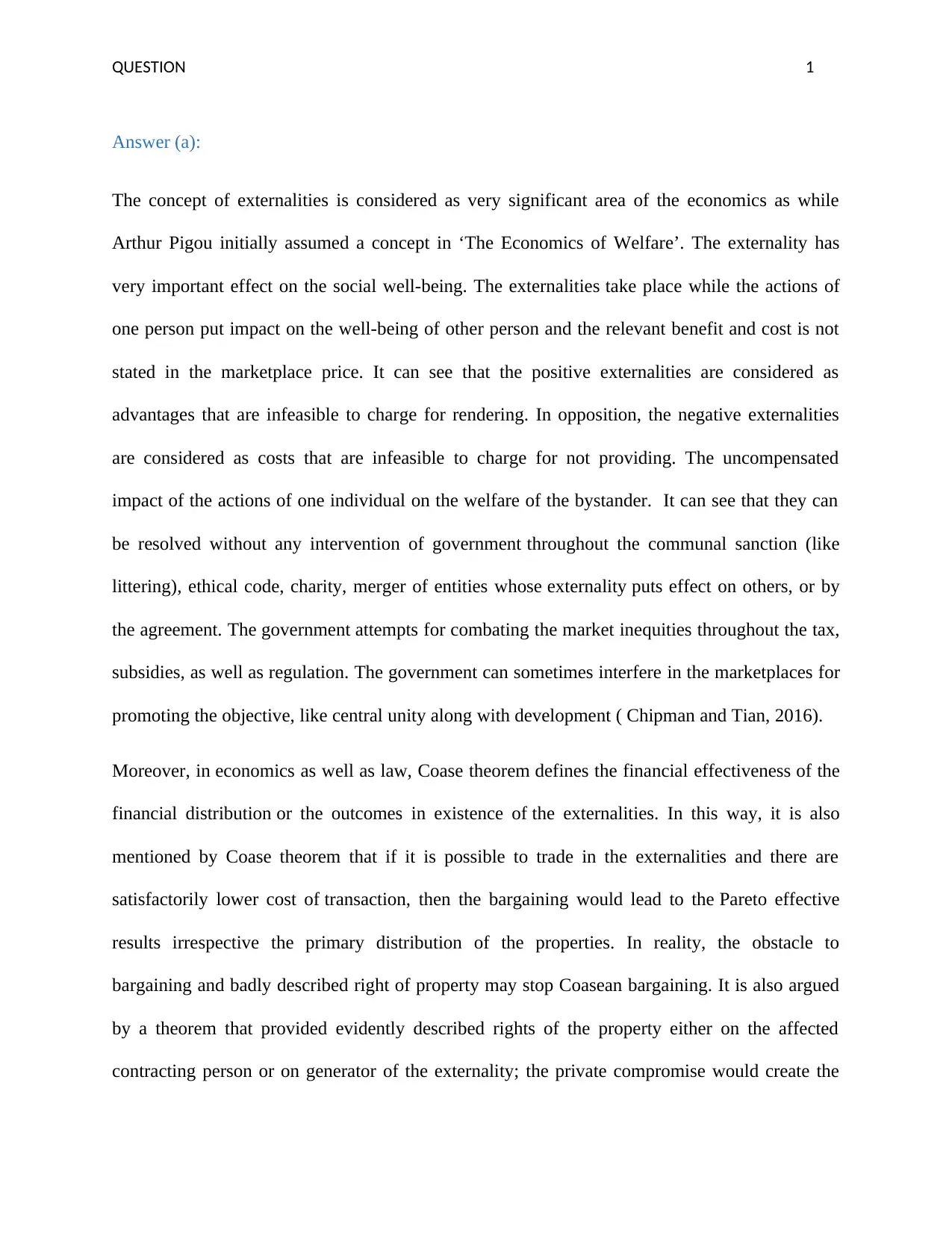
QUESTION 1
Answer (a):
The concept of externalities is considered as very significant area of the economics as while
Arthur Pigou initially assumed a concept in ‘The Economics of Welfare’. The externality has
very important effect on the social well-being. The externalities take place while the actions of
one person put impact on the well-being of other person and the relevant benefit and cost is not
stated in the marketplace price. It can see that the positive externalities are considered as
advantages that are infeasible to charge for rendering. In opposition, the negative externalities
are considered as costs that are infeasible to charge for not providing. The uncompensated
impact of the actions of one individual on the welfare of the bystander. It can see that they can
be resolved without any intervention of government throughout the communal sanction (like
littering), ethical code, charity, merger of entities whose externality puts effect on others, or by
the agreement. The government attempts for combating the market inequities throughout the tax,
subsidies, as well as regulation. The government can sometimes interfere in the marketplaces for
promoting the objective, like central unity along with development ( Chipman and Tian, 2016).
Moreover, in economics as well as law, Coase theorem defines the financial effectiveness of the
financial distribution or the outcomes in existence of the externalities. In this way, it is also
mentioned by Coase theorem that if it is possible to trade in the externalities and there are
satisfactorily lower cost of transaction, then the bargaining would lead to the Pareto effective
results irrespective the primary distribution of the properties. In reality, the obstacle to
bargaining and badly described right of property may stop Coasean bargaining. It is also argued
by a theorem that provided evidently described rights of the property either on the affected
contracting person or on generator of the externality; the private compromise would create the
Answer (a):
The concept of externalities is considered as very significant area of the economics as while
Arthur Pigou initially assumed a concept in ‘The Economics of Welfare’. The externality has
very important effect on the social well-being. The externalities take place while the actions of
one person put impact on the well-being of other person and the relevant benefit and cost is not
stated in the marketplace price. It can see that the positive externalities are considered as
advantages that are infeasible to charge for rendering. In opposition, the negative externalities
are considered as costs that are infeasible to charge for not providing. The uncompensated
impact of the actions of one individual on the welfare of the bystander. It can see that they can
be resolved without any intervention of government throughout the communal sanction (like
littering), ethical code, charity, merger of entities whose externality puts effect on others, or by
the agreement. The government attempts for combating the market inequities throughout the tax,
subsidies, as well as regulation. The government can sometimes interfere in the marketplaces for
promoting the objective, like central unity along with development ( Chipman and Tian, 2016).
Moreover, in economics as well as law, Coase theorem defines the financial effectiveness of the
financial distribution or the outcomes in existence of the externalities. In this way, it is also
mentioned by Coase theorem that if it is possible to trade in the externalities and there are
satisfactorily lower cost of transaction, then the bargaining would lead to the Pareto effective
results irrespective the primary distribution of the properties. In reality, the obstacle to
bargaining and badly described right of property may stop Coasean bargaining. It is also argued
by a theorem that provided evidently described rights of the property either on the affected
contracting person or on generator of the externality; the private compromise would create the
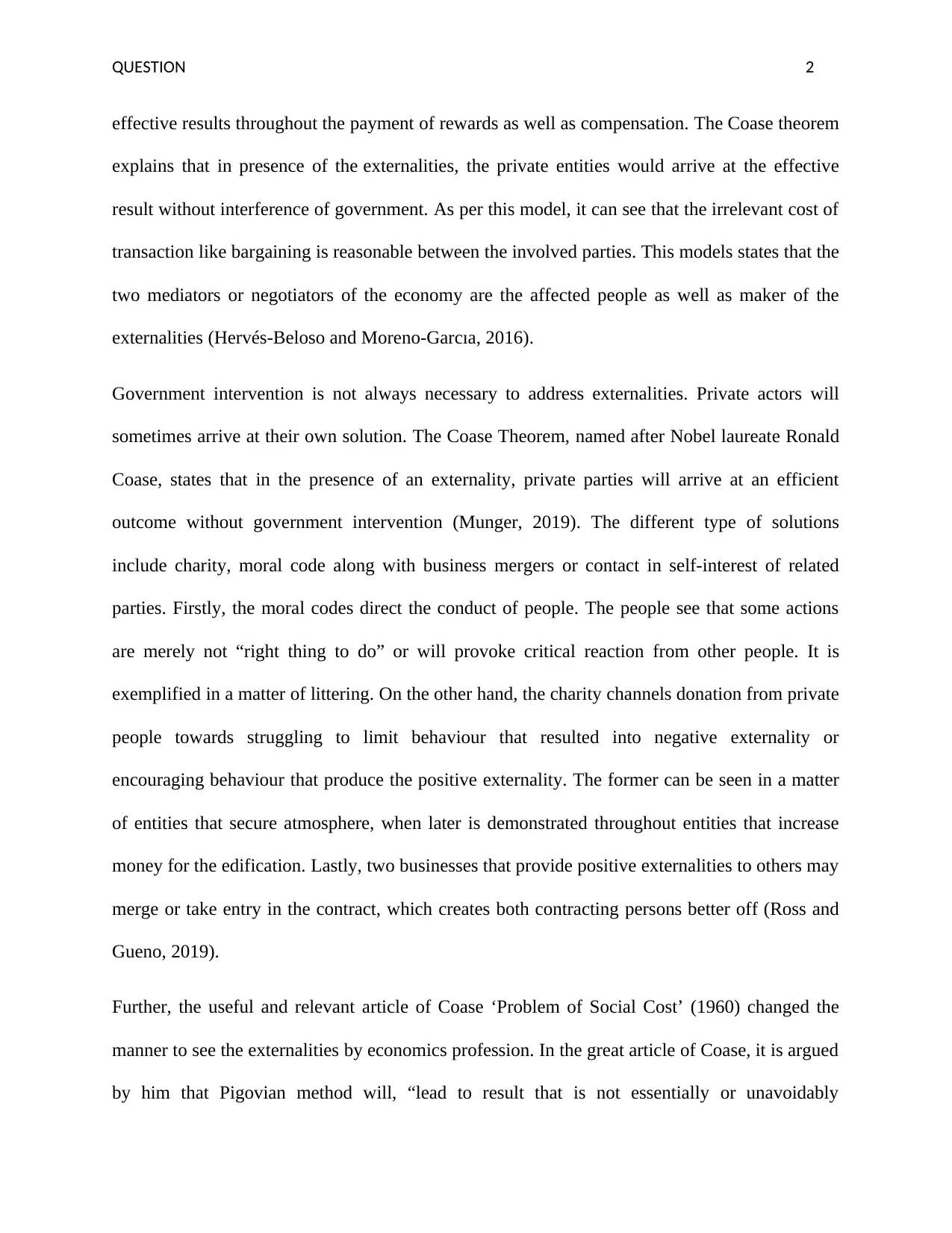
QUESTION 2
effective results throughout the payment of rewards as well as compensation. The Coase theorem
explains that in presence of the externalities, the private entities would arrive at the effective
result without interference of government. As per this model, it can see that the irrelevant cost of
transaction like bargaining is reasonable between the involved parties. This models states that the
two mediators or negotiators of the economy are the affected people as well as maker of the
externalities (Hervés-Beloso and Moreno-Garcıa, 2016).
Government intervention is not always necessary to address externalities. Private actors will
sometimes arrive at their own solution. The Coase Theorem, named after Nobel laureate Ronald
Coase, states that in the presence of an externality, private parties will arrive at an efficient
outcome without government intervention (Munger, 2019). The different type of solutions
include charity, moral code along with business mergers or contact in self-interest of related
parties. Firstly, the moral codes direct the conduct of people. The people see that some actions
are merely not “right thing to do” or will provoke critical reaction from other people. It is
exemplified in a matter of littering. On the other hand, the charity channels donation from private
people towards struggling to limit behaviour that resulted into negative externality or
encouraging behaviour that produce the positive externality. The former can be seen in a matter
of entities that secure atmosphere, when later is demonstrated throughout entities that increase
money for the edification. Lastly, two businesses that provide positive externalities to others may
merge or take entry in the contract, which creates both contracting persons better off (Ross and
Gueno, 2019).
Further, the useful and relevant article of Coase ‘Problem of Social Cost’ (1960) changed the
manner to see the externalities by economics profession. In the great article of Coase, it is argued
by him that Pigovian method will, “lead to result that is not essentially or unavoidably
effective results throughout the payment of rewards as well as compensation. The Coase theorem
explains that in presence of the externalities, the private entities would arrive at the effective
result without interference of government. As per this model, it can see that the irrelevant cost of
transaction like bargaining is reasonable between the involved parties. This models states that the
two mediators or negotiators of the economy are the affected people as well as maker of the
externalities (Hervés-Beloso and Moreno-Garcıa, 2016).
Government intervention is not always necessary to address externalities. Private actors will
sometimes arrive at their own solution. The Coase Theorem, named after Nobel laureate Ronald
Coase, states that in the presence of an externality, private parties will arrive at an efficient
outcome without government intervention (Munger, 2019). The different type of solutions
include charity, moral code along with business mergers or contact in self-interest of related
parties. Firstly, the moral codes direct the conduct of people. The people see that some actions
are merely not “right thing to do” or will provoke critical reaction from other people. It is
exemplified in a matter of littering. On the other hand, the charity channels donation from private
people towards struggling to limit behaviour that resulted into negative externality or
encouraging behaviour that produce the positive externality. The former can be seen in a matter
of entities that secure atmosphere, when later is demonstrated throughout entities that increase
money for the edification. Lastly, two businesses that provide positive externalities to others may
merge or take entry in the contract, which creates both contracting persons better off (Ross and
Gueno, 2019).
Further, the useful and relevant article of Coase ‘Problem of Social Cost’ (1960) changed the
manner to see the externalities by economics profession. In the great article of Coase, it is argued
by him that Pigovian method will, “lead to result that is not essentially or unavoidably
⊘ This is a preview!⊘
Do you want full access?
Subscribe today to unlock all pages.

Trusted by 1+ million students worldwide
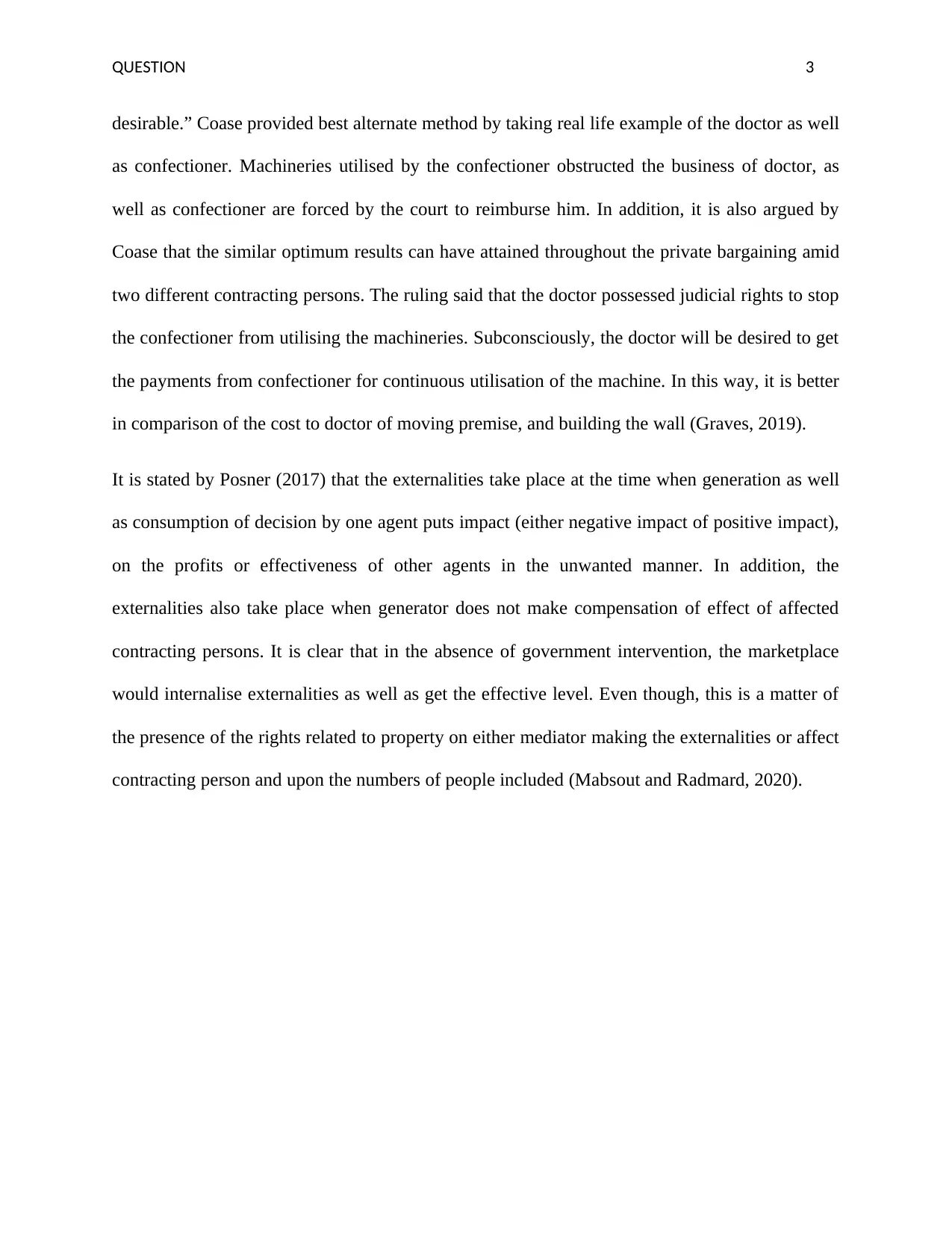
QUESTION 3
desirable.” Coase provided best alternate method by taking real life example of the doctor as well
as confectioner. Machineries utilised by the confectioner obstructed the business of doctor, as
well as confectioner are forced by the court to reimburse him. In addition, it is also argued by
Coase that the similar optimum results can have attained throughout the private bargaining amid
two different contracting persons. The ruling said that the doctor possessed judicial rights to stop
the confectioner from utilising the machineries. Subconsciously, the doctor will be desired to get
the payments from confectioner for continuous utilisation of the machine. In this way, it is better
in comparison of the cost to doctor of moving premise, and building the wall (Graves, 2019).
It is stated by Posner (2017) that the externalities take place at the time when generation as well
as consumption of decision by one agent puts impact (either negative impact of positive impact),
on the profits or effectiveness of other agents in the unwanted manner. In addition, the
externalities also take place when generator does not make compensation of effect of affected
contracting persons. It is clear that in the absence of government intervention, the marketplace
would internalise externalities as well as get the effective level. Even though, this is a matter of
the presence of the rights related to property on either mediator making the externalities or affect
contracting person and upon the numbers of people included (Mabsout and Radmard, 2020).
desirable.” Coase provided best alternate method by taking real life example of the doctor as well
as confectioner. Machineries utilised by the confectioner obstructed the business of doctor, as
well as confectioner are forced by the court to reimburse him. In addition, it is also argued by
Coase that the similar optimum results can have attained throughout the private bargaining amid
two different contracting persons. The ruling said that the doctor possessed judicial rights to stop
the confectioner from utilising the machineries. Subconsciously, the doctor will be desired to get
the payments from confectioner for continuous utilisation of the machine. In this way, it is better
in comparison of the cost to doctor of moving premise, and building the wall (Graves, 2019).
It is stated by Posner (2017) that the externalities take place at the time when generation as well
as consumption of decision by one agent puts impact (either negative impact of positive impact),
on the profits or effectiveness of other agents in the unwanted manner. In addition, the
externalities also take place when generator does not make compensation of effect of affected
contracting persons. It is clear that in the absence of government intervention, the marketplace
would internalise externalities as well as get the effective level. Even though, this is a matter of
the presence of the rights related to property on either mediator making the externalities or affect
contracting person and upon the numbers of people included (Mabsout and Radmard, 2020).
Paraphrase This Document
Need a fresh take? Get an instant paraphrase of this document with our AI Paraphraser
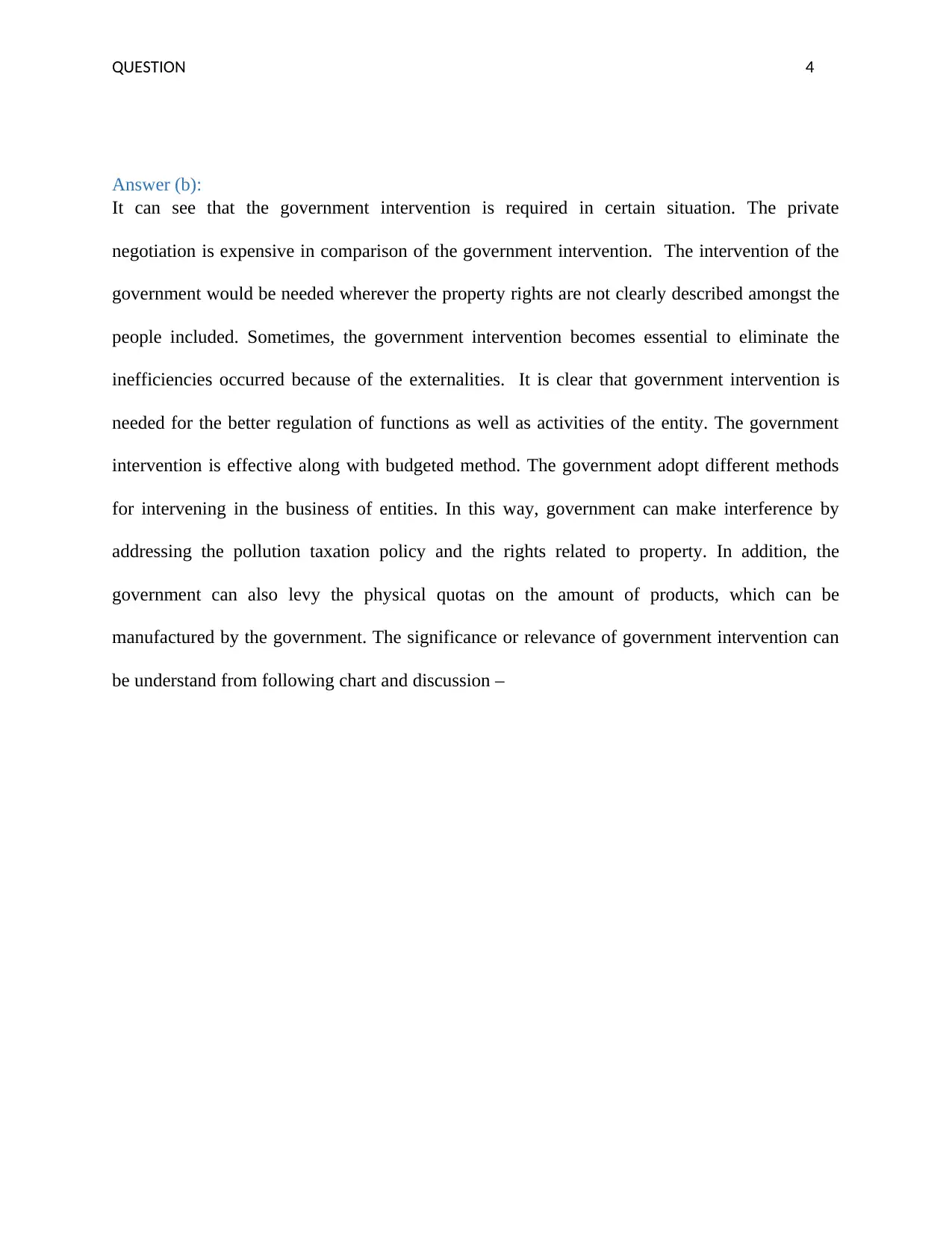
QUESTION 4
Answer (b):
It can see that the government intervention is required in certain situation. The private
negotiation is expensive in comparison of the government intervention. The intervention of the
government would be needed wherever the property rights are not clearly described amongst the
people included. Sometimes, the government intervention becomes essential to eliminate the
inefficiencies occurred because of the externalities. It is clear that government intervention is
needed for the better regulation of functions as well as activities of the entity. The government
intervention is effective along with budgeted method. The government adopt different methods
for intervening in the business of entities. In this way, government can make interference by
addressing the pollution taxation policy and the rights related to property. In addition, the
government can also levy the physical quotas on the amount of products, which can be
manufactured by the government. The significance or relevance of government intervention can
be understand from following chart and discussion –
Answer (b):
It can see that the government intervention is required in certain situation. The private
negotiation is expensive in comparison of the government intervention. The intervention of the
government would be needed wherever the property rights are not clearly described amongst the
people included. Sometimes, the government intervention becomes essential to eliminate the
inefficiencies occurred because of the externalities. It is clear that government intervention is
needed for the better regulation of functions as well as activities of the entity. The government
intervention is effective along with budgeted method. The government adopt different methods
for intervening in the business of entities. In this way, government can make interference by
addressing the pollution taxation policy and the rights related to property. In addition, the
government can also levy the physical quotas on the amount of products, which can be
manufactured by the government. The significance or relevance of government intervention can
be understand from following chart and discussion –
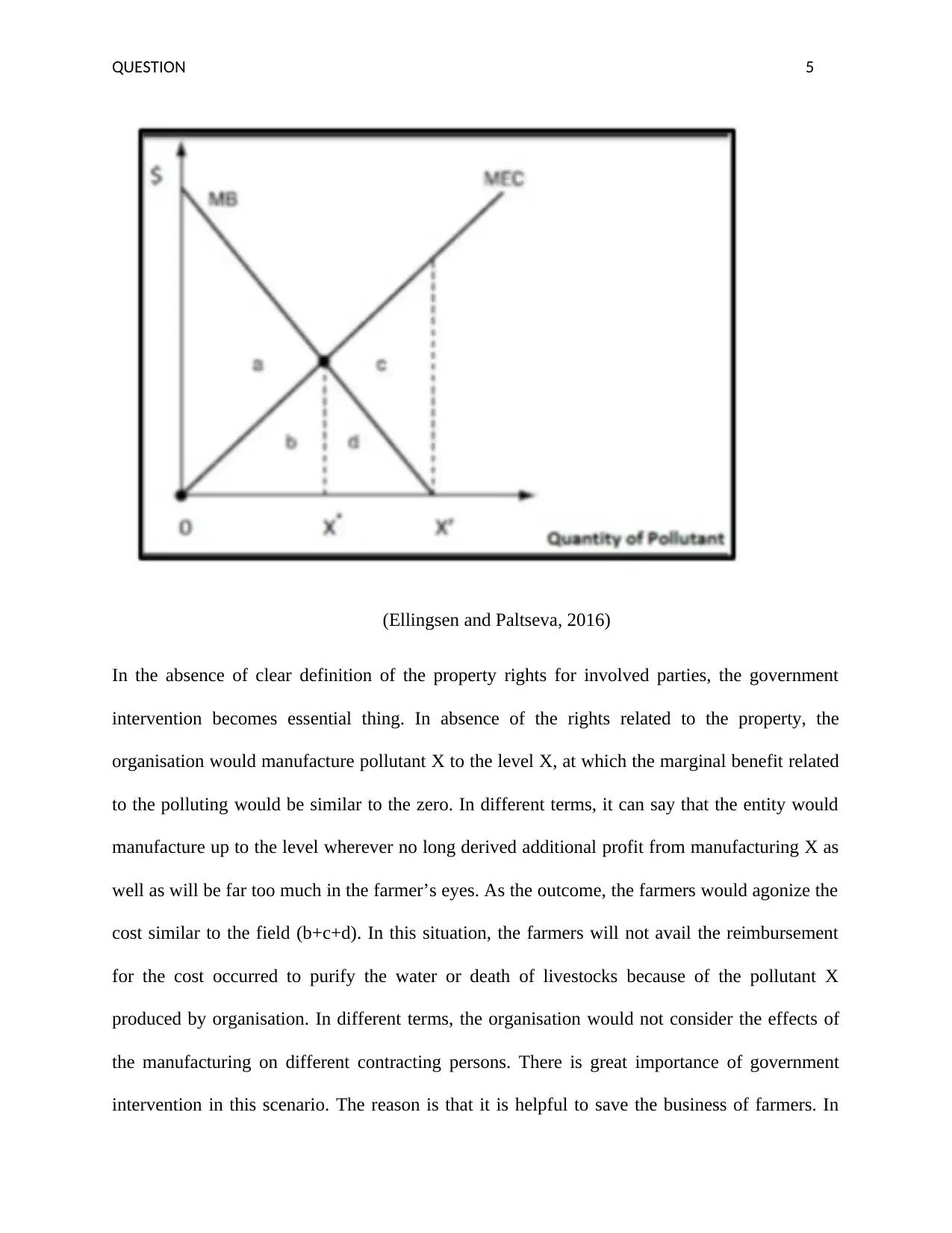
QUESTION 5
(Ellingsen and Paltseva, 2016)
In the absence of clear definition of the property rights for involved parties, the government
intervention becomes essential thing. In absence of the rights related to the property, the
organisation would manufacture pollutant X to the level X, at which the marginal benefit related
to the polluting would be similar to the zero. In different terms, it can say that the entity would
manufacture up to the level wherever no long derived additional profit from manufacturing X as
well as will be far too much in the farmer’s eyes. As the outcome, the farmers would agonize the
cost similar to the field (b+c+d). In this situation, the farmers will not avail the reimbursement
for the cost occurred to purify the water or death of livestocks because of the pollutant X
produced by organisation. In different terms, the organisation would not consider the effects of
the manufacturing on different contracting persons. There is great importance of government
intervention in this scenario. The reason is that it is helpful to save the business of farmers. In
(Ellingsen and Paltseva, 2016)
In the absence of clear definition of the property rights for involved parties, the government
intervention becomes essential thing. In absence of the rights related to the property, the
organisation would manufacture pollutant X to the level X, at which the marginal benefit related
to the polluting would be similar to the zero. In different terms, it can say that the entity would
manufacture up to the level wherever no long derived additional profit from manufacturing X as
well as will be far too much in the farmer’s eyes. As the outcome, the farmers would agonize the
cost similar to the field (b+c+d). In this situation, the farmers will not avail the reimbursement
for the cost occurred to purify the water or death of livestocks because of the pollutant X
produced by organisation. In different terms, the organisation would not consider the effects of
the manufacturing on different contracting persons. There is great importance of government
intervention in this scenario. The reason is that it is helpful to save the business of farmers. In
⊘ This is a preview!⊘
Do you want full access?
Subscribe today to unlock all pages.

Trusted by 1+ million students worldwide
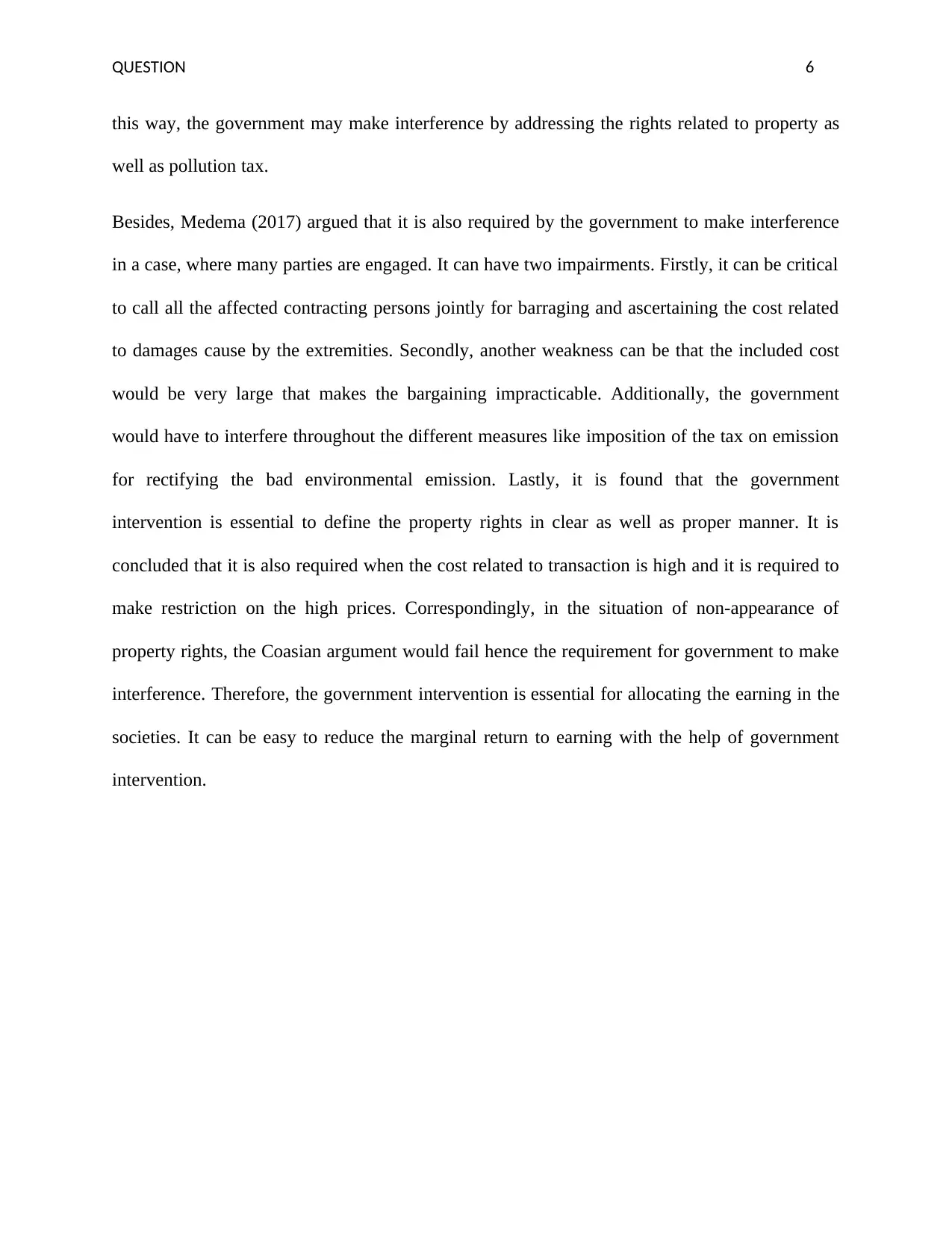
QUESTION 6
this way, the government may make interference by addressing the rights related to property as
well as pollution tax.
Besides, Medema (2017) argued that it is also required by the government to make interference
in a case, where many parties are engaged. It can have two impairments. Firstly, it can be critical
to call all the affected contracting persons jointly for barraging and ascertaining the cost related
to damages cause by the extremities. Secondly, another weakness can be that the included cost
would be very large that makes the bargaining impracticable. Additionally, the government
would have to interfere throughout the different measures like imposition of the tax on emission
for rectifying the bad environmental emission. Lastly, it is found that the government
intervention is essential to define the property rights in clear as well as proper manner. It is
concluded that it is also required when the cost related to transaction is high and it is required to
make restriction on the high prices. Correspondingly, in the situation of non-appearance of
property rights, the Coasian argument would fail hence the requirement for government to make
interference. Therefore, the government intervention is essential for allocating the earning in the
societies. It can be easy to reduce the marginal return to earning with the help of government
intervention.
this way, the government may make interference by addressing the rights related to property as
well as pollution tax.
Besides, Medema (2017) argued that it is also required by the government to make interference
in a case, where many parties are engaged. It can have two impairments. Firstly, it can be critical
to call all the affected contracting persons jointly for barraging and ascertaining the cost related
to damages cause by the extremities. Secondly, another weakness can be that the included cost
would be very large that makes the bargaining impracticable. Additionally, the government
would have to interfere throughout the different measures like imposition of the tax on emission
for rectifying the bad environmental emission. Lastly, it is found that the government
intervention is essential to define the property rights in clear as well as proper manner. It is
concluded that it is also required when the cost related to transaction is high and it is required to
make restriction on the high prices. Correspondingly, in the situation of non-appearance of
property rights, the Coasian argument would fail hence the requirement for government to make
interference. Therefore, the government intervention is essential for allocating the earning in the
societies. It can be easy to reduce the marginal return to earning with the help of government
intervention.
Paraphrase This Document
Need a fresh take? Get an instant paraphrase of this document with our AI Paraphraser
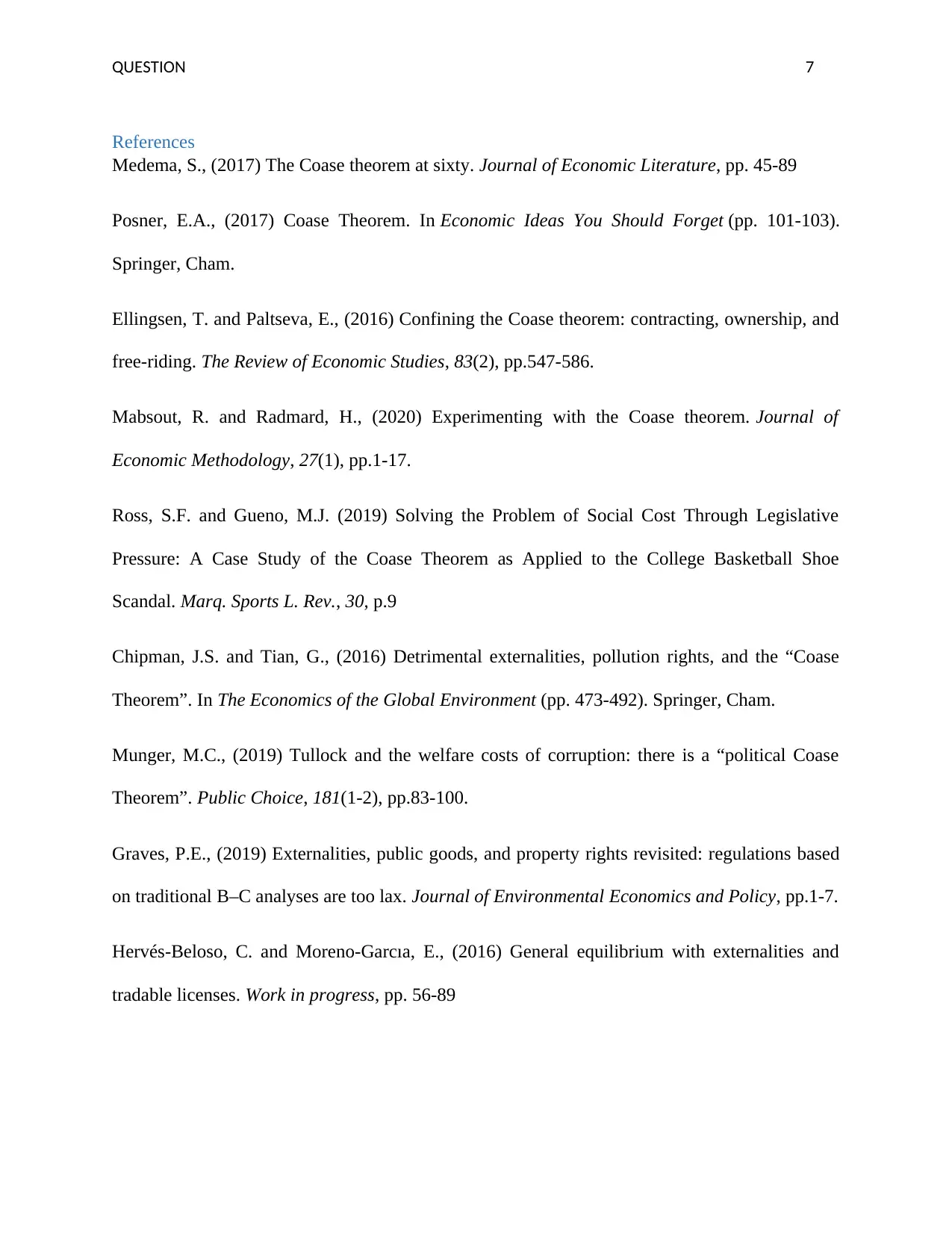
QUESTION 7
References
Medema, S., (2017) The Coase theorem at sixty. Journal of Economic Literature, pp. 45-89
Posner, E.A., (2017) Coase Theorem. In Economic Ideas You Should Forget (pp. 101-103).
Springer, Cham.
Ellingsen, T. and Paltseva, E., (2016) Confining the Coase theorem: contracting, ownership, and
free-riding. The Review of Economic Studies, 83(2), pp.547-586.
Mabsout, R. and Radmard, H., (2020) Experimenting with the Coase theorem. Journal of
Economic Methodology, 27(1), pp.1-17.
Ross, S.F. and Gueno, M.J. (2019) Solving the Problem of Social Cost Through Legislative
Pressure: A Case Study of the Coase Theorem as Applied to the College Basketball Shoe
Scandal. Marq. Sports L. Rev., 30, p.9
Chipman, J.S. and Tian, G., (2016) Detrimental externalities, pollution rights, and the “Coase
Theorem”. In The Economics of the Global Environment (pp. 473-492). Springer, Cham.
Munger, M.C., (2019) Tullock and the welfare costs of corruption: there is a “political Coase
Theorem”. Public Choice, 181(1-2), pp.83-100.
Graves, P.E., (2019) Externalities, public goods, and property rights revisited: regulations based
on traditional B–C analyses are too lax. Journal of Environmental Economics and Policy, pp.1-7.
Hervés-Beloso, C. and Moreno-Garcıa, E., (2016) General equilibrium with externalities and
tradable licenses. Work in progress, pp. 56-89
References
Medema, S., (2017) The Coase theorem at sixty. Journal of Economic Literature, pp. 45-89
Posner, E.A., (2017) Coase Theorem. In Economic Ideas You Should Forget (pp. 101-103).
Springer, Cham.
Ellingsen, T. and Paltseva, E., (2016) Confining the Coase theorem: contracting, ownership, and
free-riding. The Review of Economic Studies, 83(2), pp.547-586.
Mabsout, R. and Radmard, H., (2020) Experimenting with the Coase theorem. Journal of
Economic Methodology, 27(1), pp.1-17.
Ross, S.F. and Gueno, M.J. (2019) Solving the Problem of Social Cost Through Legislative
Pressure: A Case Study of the Coase Theorem as Applied to the College Basketball Shoe
Scandal. Marq. Sports L. Rev., 30, p.9
Chipman, J.S. and Tian, G., (2016) Detrimental externalities, pollution rights, and the “Coase
Theorem”. In The Economics of the Global Environment (pp. 473-492). Springer, Cham.
Munger, M.C., (2019) Tullock and the welfare costs of corruption: there is a “political Coase
Theorem”. Public Choice, 181(1-2), pp.83-100.
Graves, P.E., (2019) Externalities, public goods, and property rights revisited: regulations based
on traditional B–C analyses are too lax. Journal of Environmental Economics and Policy, pp.1-7.
Hervés-Beloso, C. and Moreno-Garcıa, E., (2016) General equilibrium with externalities and
tradable licenses. Work in progress, pp. 56-89
1 out of 8
Your All-in-One AI-Powered Toolkit for Academic Success.
+13062052269
info@desklib.com
Available 24*7 on WhatsApp / Email
![[object Object]](/_next/static/media/star-bottom.7253800d.svg)
Unlock your academic potential
Copyright © 2020–2025 A2Z Services. All Rights Reserved. Developed and managed by ZUCOL.
